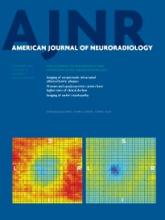Research ArticleNeurointervention
Spontaneous Delayed Migration/Shortening of the Pipeline Embolization Device: Report of 5 Cases
N. Chalouhi, S.I. Tjoumakaris, L.F. Gonzalez, D. Hasan, P.J. Pema, G. Gould, R.H. Rosenwasser and P.M. Jabbour
American Journal of Neuroradiology December 2013, 34 (12) 2326-2330; DOI: https://doi.org/10.3174/ajnr.A3632
N. Chalouhi
aFrom the Department of Neurosurgery (N.C., S.I.T., L.F.G., G.G., R.H.R., P.M.J.), Thomas Jefferson University and Jefferson Hospital for Neuroscience, Philadelphia, Pennsylvania
S.I. Tjoumakaris
aFrom the Department of Neurosurgery (N.C., S.I.T., L.F.G., G.G., R.H.R., P.M.J.), Thomas Jefferson University and Jefferson Hospital for Neuroscience, Philadelphia, Pennsylvania
L.F. Gonzalez
aFrom the Department of Neurosurgery (N.C., S.I.T., L.F.G., G.G., R.H.R., P.M.J.), Thomas Jefferson University and Jefferson Hospital for Neuroscience, Philadelphia, Pennsylvania
D. Hasan
bDepartment of Neurosurgery (D.H.), University of Iowa, Iowa City, Iowa
P.J. Pema
cDepartment of Radiology (P.J.P.), Riverside Methodist Hospital, Columbus, Ohio.
G. Gould
aFrom the Department of Neurosurgery (N.C., S.I.T., L.F.G., G.G., R.H.R., P.M.J.), Thomas Jefferson University and Jefferson Hospital for Neuroscience, Philadelphia, Pennsylvania
R.H. Rosenwasser
aFrom the Department of Neurosurgery (N.C., S.I.T., L.F.G., G.G., R.H.R., P.M.J.), Thomas Jefferson University and Jefferson Hospital for Neuroscience, Philadelphia, Pennsylvania
P.M. Jabbour
aFrom the Department of Neurosurgery (N.C., S.I.T., L.F.G., G.G., R.H.R., P.M.J.), Thomas Jefferson University and Jefferson Hospital for Neuroscience, Philadelphia, Pennsylvania

Submit a Response to This Article
Jump to comment:
No eLetters have been published for this article.
In this issue
American Journal of Neuroradiology
Vol. 34, Issue 12
1 Dec 2013
Advertisement
N. Chalouhi, S.I. Tjoumakaris, L.F. Gonzalez, D. Hasan, P.J. Pema, G. Gould, R.H. Rosenwasser, P.M. Jabbour
Spontaneous Delayed Migration/Shortening of the Pipeline Embolization Device: Report of 5 Cases
American Journal of Neuroradiology Dec 2013, 34 (12) 2326-2330; DOI: 10.3174/ajnr.A3632
Jump to section
Related Articles
- No related articles found.
Cited By...
- Flow diverter braid deformation following treatment of cerebral aneurysms: incidence, clinical relevance, and potential risk factors
- Spontaneous delayed migration or shortening after pipeline embolization device treatment of intracranial aneurysm: incidence, management, and risk factors
- Efficacy and safety of the dual-layer flow-diverting stent (FRED) for the treatment of intracranial aneurysms
- Ophthalmic artery occlusion after Pipeline Embolization Device placement with reconstitution of flow via an endoleak: a report of two cases
- Republished: Novel balloon application for rescue and realignment of a proximal end migrated pipeline flex embolization device into the aneurysmal sac: complication management
- Republished: Spontaneous regression of intracranial aneurysm following remote ruptured aneurysm treatment with pipeline stent assisted coiling
- Endovascular treatment of intracranial aneurysms using the Pipeline Flex embolization device: a case series of 30 consecutive patients
- Novel balloon application for rescue and realignment of a proximal end migrated pipeline flex embolization device into the aneurysmal sac: complication management
- Flow Diversion versus Standard Endovascular Techniques for the Treatment of Unruptured Carotid-Ophthalmic Aneurysms
- Initial Experience with p64: A Novel Mechanically Detachable Flow Diverter for the Treatment of Intracranial Saccular Sidewall Aneurysms
- Utilization of Pipeline embolization device for treatment of ruptured intracranial aneurysms: US multicenter experience
- Preliminary experience with the Pipeline Flex Embolization Device: technical note
- Focal, transient mechanical narrowing of a pipeline embolization device following treatment of an internal carotid artery aneurysm
- Spontaneous regression of intracranial aneurysm following remote ruptured aneurysm treatment with pipeline stent assisted coiling
- Focal, transient mechanical narrowing of a pipeline embolization device following treatment of an internal carotid artery aneurysm
- Effect of Structural Remodeling (Retraction and Recoil) of the Pipeline Embolization Device on Aneurysm Occlusion Rate
- A Single Pipeline Embolization Device is Sufficient for Treatment of Intracranial Aneurysms
This article has not yet been cited by articles in journals that are participating in Crossref Cited-by Linking.
More in this TOC Section
Similar Articles
Advertisement











